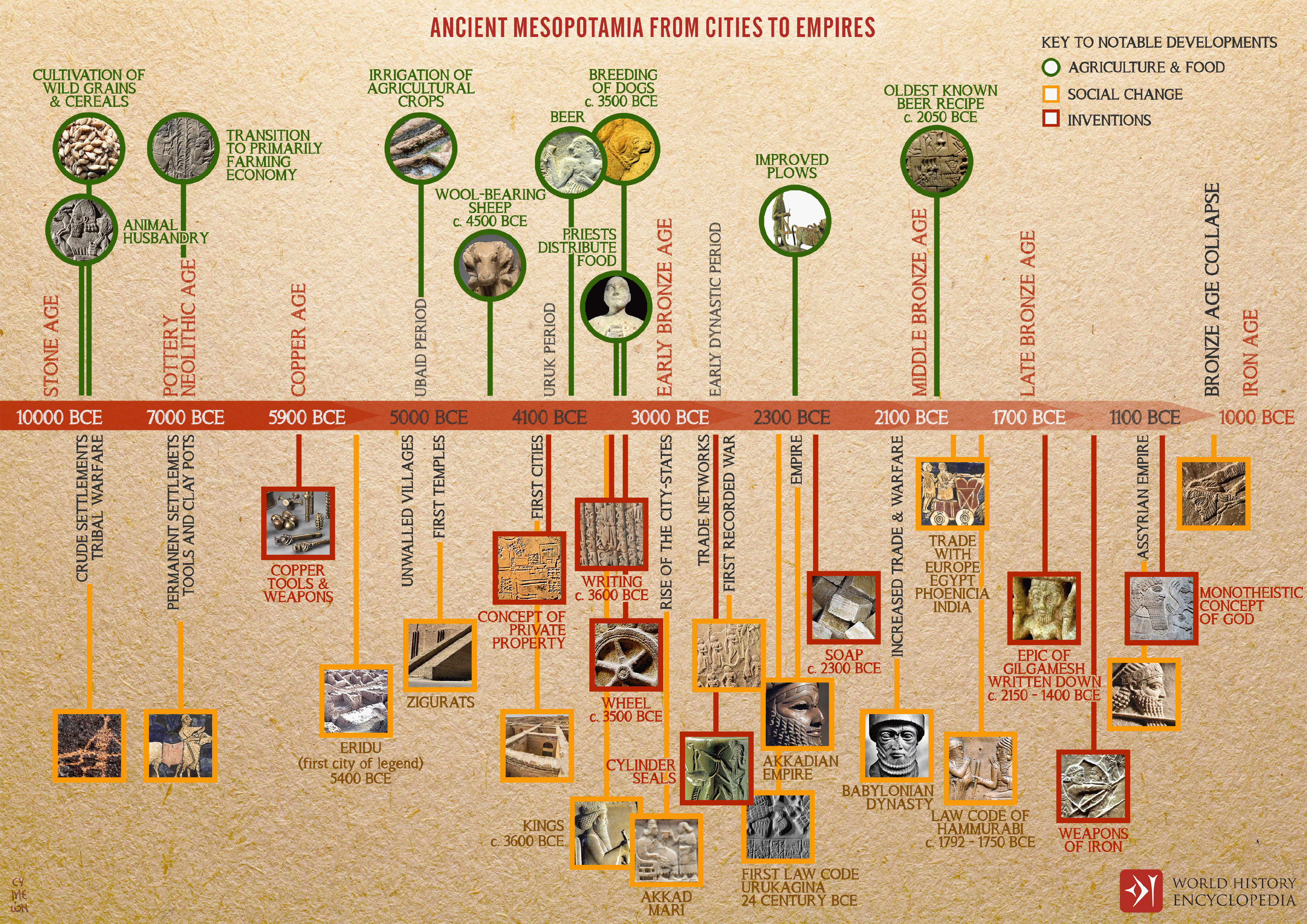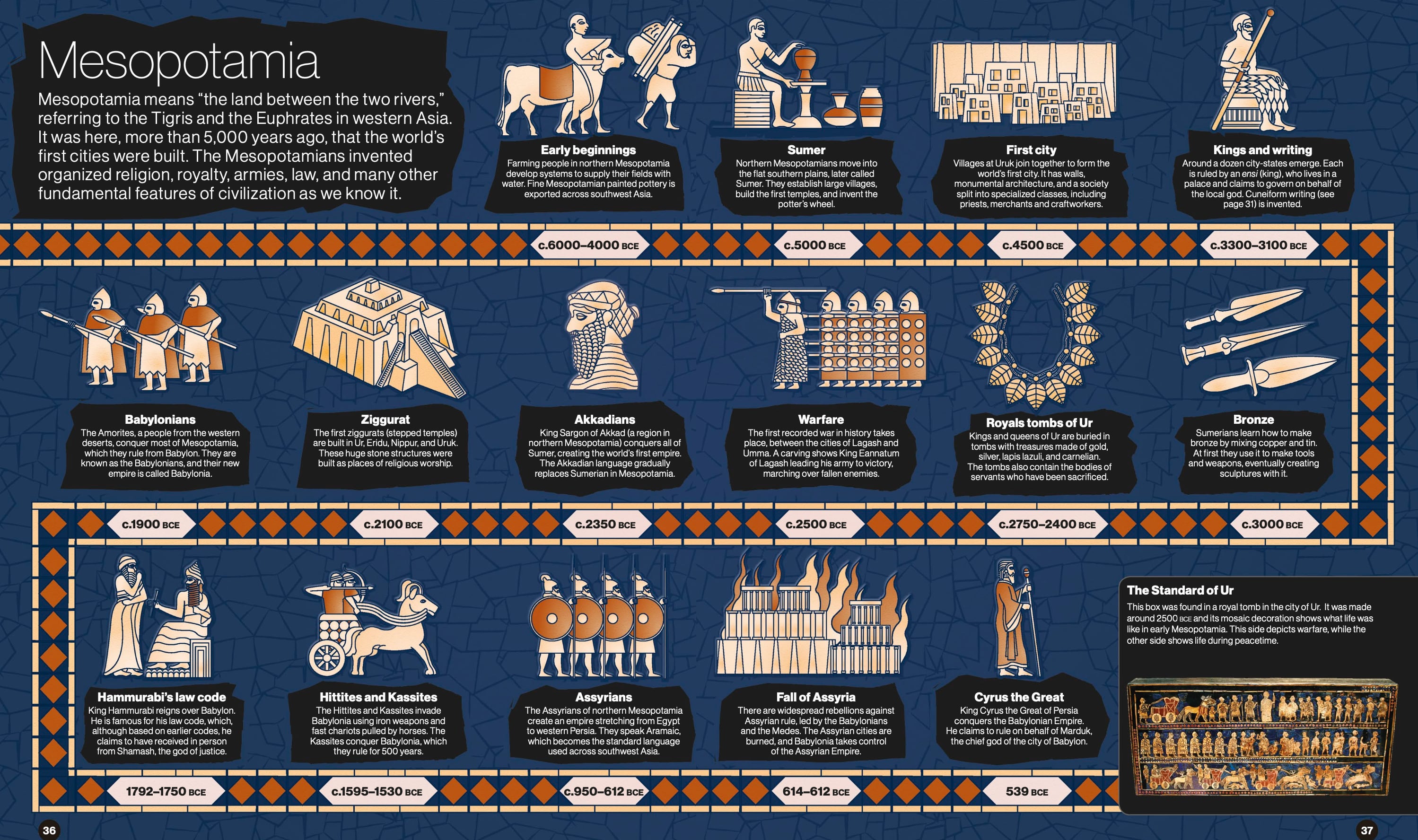The Empires of Mesopotamia Timeline: A Chronological Journey Through History offers a fascinating insight into the rise and fall of one of the world’s most ancient civilizations. Did you know that Mesopotamia, the land located between the Tigris and Euphrates rivers, is often referred to as the “cradle of civilization”? This captivating timeline takes you on a journey through the various empires that ruled Mesopotamia, showcasing their achievements, innovations, and conflicts that shaped the region’s rich history.
This comprehensive timeline delves into the early city-states of Sumer, the mighty Akkadian Empire, the cosmopolitan Babylonian Empire, and the powerful Assyrian Empire, among others. It provides a valuable resource for understanding the political, social, and cultural developments of Mesopotamia. With engaging content that blends historical facts and captivating storytelling, this timeline offers a unique perspective on the complexities of ancient Mesopotamian civilization.
Explore the Empires of Mesopotamia’s timeline and immerse yourself in a fascinating journey through history. From the mighty Akkadian Empire to the legendary Babylonian Empire, this chronological timeline provides a comprehensive overview of the rise and fall of these ancient civilizations. Discover the contributions, achievements, and cultural aspects of each empire that shaped the history of Mesopotamia. Embark on this educational journey and gain a deeper understanding of the Empires of Mesopotamia.

Contents
- Introduction to the Empires of Mesopotamia Timeline
- Empires of Mesopotamia Timeline: A Chronological Journey Through History
- The Entire History of the Akkadians // Ancient Mesopotamia Documentary
- Key Takeaways
- Frequently Asked Questions
- The Entire History of the Akkadians // Ancient Mesopotamia Documentary
Introduction to the Empires of Mesopotamia Timeline
Mesopotamia, known as the “land between the rivers,” is widely regarded as the birthplace of civilization. Situated in present-day Iraq and parts of Iran, Syria, and Turkey, Mesopotamia was occupied by numerous empires throughout history. This article provides a chronological journey through the empires of Mesopotamia, highlighting their rise, fall, significant achievements, and impact on the development of human civilization.
1. The Sumerian Empire (c. 4500-1900 BCE)
The Sumerian Empire, which emerged around 4500 BCE, is considered the first civilization in human history. Located in southern Mesopotamia, Sumerians developed a sophisticated society characterized by advanced irrigation systems, the invention of writing (cuneiform script), monumental architecture, and complex social and economic structures.
One of the most remarkable legacies of the Sumerian Empire was the creation of city-states, each with its own government and patron deity. The city-state of Uruk, for example, was famous for its ziggurat, a massive stepped pyramid dedicated to the sky god Anu. Another significant accomplishment of the Sumerians was the invention of the wheel, which revolutionized transportation and trade.
Despite their cultural and technological achievements, the Sumerians faced numerous challenges, including invasions, conflicts, and environmental issues. Around 2000 BCE, the Sumerian Empire gradually declined, giving rise to new empires in the region.
1.1 Babylonian Empire (c. 1894-1595 BCE)
The Babylonian Empire, centered in the city of Babylon, emerged as a dominant power in Mesopotamia after the decline of the Sumerian Empire. Under the rule of King Hammurabi, the Babylonian Empire reached its peak during the Old Babylonian period (1894-1595 BCE). Hammurabi is most famous for his comprehensive legal code, known as the Code of Hammurabi, which established a system of justice and regulations for daily life.
The Babylonians were also significant contributors to knowledge and scholarship. They were meticulous record-keepers and made advancements in mathematics, astronomy, and literature. The city of Babylon itself became a cultural and commercial hub, with the Hanging Gardens of Babylon being one of the Seven Wonders of the Ancient World.
However, internal conflicts and external invasions eventually weakened the Babylonian Empire. In 1595 BCE, the empire fell to the Hittites, marking the end of the Old Babylonian period.
1.2 Assyrian Empire (c. 2025-609 BCE)
The Assyrians, originally a small city-state in northern Mesopotamia, rose to power around 2025 BCE. They developed a highly efficient military apparatus and became known for their brutal conquests and imperial expansion. Under the rule of kings such as Tiglath-Pileser III and Ashurbanipal, the Neo-Assyrian Empire (911-609 BCE) reached its height, encompassing vast territories from Egypt to Persia.
The Assyrians pioneered innovative military strategies and organizational systems, employing skilled archers, cavalry, and siege warfare techniques. They also constructed grand capital cities, with Nineveh serving as one of the most prominent.
Despite their military prowess, the Assyrians faced ongoing rebellions and eventually succumbed to internal strife and external invasions. In 609 BCE, the Neo-Babylonians, led by king Nabopolassar, conquered Nineveh, bringing an end to the Assyrian Empire.
2. The Babylonian Empire (c. 626-539 BCE)
The second Babylonian Empire, also known as the Neo-Babylonian or Chaldean Empire, emerged in the 7th century BCE after the fall of the Assyrian Empire. Its most famous ruler was King Nebuchadnezzar II, who rebuilt the city of Babylon and created elaborate structures such as the Ishtar Gate.
The Neo-Babylonian Empire reached its zenith under Nebuchadnezzar II, becoming a major power in the region. However, the empire faced significant challenges, including conflicts with neighboring kingdoms and the rise of the Persian Empire.
In 539 BCE, the Neo-Babylonian Empire fell to the Persian conqueror Cyrus the Great, marking the end of Babylonian dominance in Mesopotamia.
2.1 Persian Empire (c. 550-330 BCE)
The Persian Empire, also known as the Achaemenid Empire, was one of the largest and most influential empires in ancient history. Under the leadership of Cyrus the Great, the Persians defeated the Neo-Babylonians and established their dominance over Mesopotamia.
The Persian Empire was characterized by a centralized administration, infrastructure development, and cultural assimilation. Cyrus the Great implemented a policy of religious and cultural tolerance, allowing conquered peoples to retain their customs and beliefs.
The Persian Empire reached its height under the reign of Darius I, who expanded its territories to include Egypt, Greece, and parts of India. The empire’s decline began with the invasion by Alexander the Great in 331 BCE, eventually leading to its downfall.
3. The Seleucid Empire (c. 312-63 BCE)
Following the conquest of Persia by Alexander the Great, a period of Hellenistic rule began in Mesopotamia. The Seleucid Empire, founded by Seleucus I Nicator, emerged as the successor state to Alexander’s empire in the region.
The Seleucids, of Greek-Macedonian descent, sought to Hellenize the region by promoting Greek culture and language. However, they faced resistance from local populations and frequent revolts.
The Seleucid Empire gradually fragmented due to internal conflicts and external invasions by Parthians, Romans, and other neighboring powers. By 63 BCE, it was reduced to a small kingdom before being absorbed by the expanding Roman Empire.
4. The Parthian Empire (c. 247 BCE-224 CE)
The Parthian Empire rose to power in Mesopotamia following the decline of the Seleucid Empire. The Parthians, originally a confederation of nomadic tribes from Central Asia, established a powerful empire renowned for its cavalry superiority and military tactics.
The Parthian Empire engaged in conflicts with the Roman Empire, often leading to territorial shifts. Despite frequent border conflicts, the two empires also engaged in significant trade and cultural exchange along the Silk Road.
In 224 CE, the Parthian Empire was overthrown by the Sassanian dynasty, marking the end of Parthian rule in Mesopotamia.
5. The Sassanian Empire (c. 224-651 CE)
The Sassanian Empire, founded by Ardashir I, became the last native Persian dynasty to rule over Mesopotamia. The Sassanians sought to revive Persian culture and Zoroastrianism, the state religion.
The Sassanian Empire experienced periods of territorial expansion and contraction, engaging in frequent conflicts with the Byzantine Empire. The empire’s reign of Khosrow II marked a period of significant territorial gains in Mesopotamia.
However, the Sassanian Empire faced external threats from the expanding Arab-Islamic forces. In 651 CE, the Rashidun Caliphate defeated the Sassanians, marking the end of their empire and the beginning of Arab-Muslim rule in Mesopotamia.
The empires of Mesopotamia left an indelible mark on human civilization, influencing language, governance, law, architecture, and various fields of knowledge. They set the stage for subsequent empires and the development of the modern world.

Empires of Mesopotamia Timeline: A Chronological Journey Through History
Mesopotamia, known as the “Cradle of Civilization,” witnessed the rise and fall of several powerful empires throughout history. This timeline provides a chronological overview of these empires:
1. Sumerian Civilization (c. 4500 BCE – c. 1900 BCE)
The Sumerians were the earliest known civilization in Mesopotamia. They developed the first form of writing known as cuneiform, built magnificent cities like Ur and Uruk, and left behind a rich legacy of literature and law.
2. Akkadian Empire (c. 2334 BCE – c. 2154 BCE)
Under the rule of Sargon the Great, the Akkadian Empire became the first multiethnic empire in history. It expanded its influence across Mesopotamia and established Akkad as its capital.
3. Babylonian Empire (c. 1894 BCE – c. 539 BCE)
The Babylonians, led by Hammurabi, created one of the most famous legal codes in history – the Code of Hammurabi. They built the city of Babylon, which became a center of trade and culture in the ancient world.
4. Assyrian Empire (c. 1813 BCE – c. 612 BCE)
• Mesopotamian art and architecture influenced the aesthetics of later civilizations, with elements such as monumental buildings and intricate carvings being replicated in various forms.